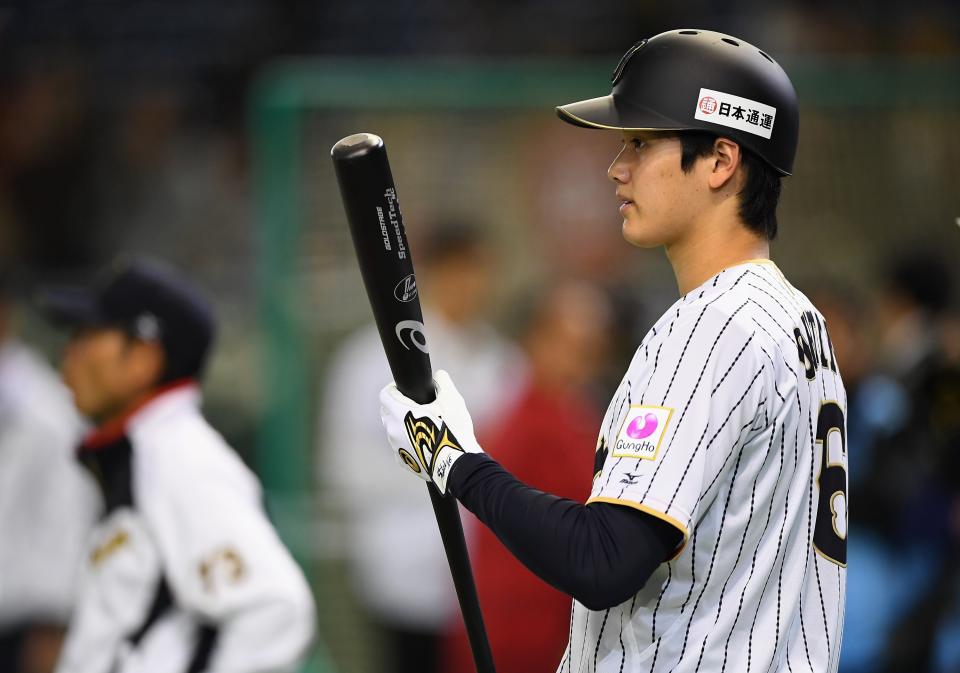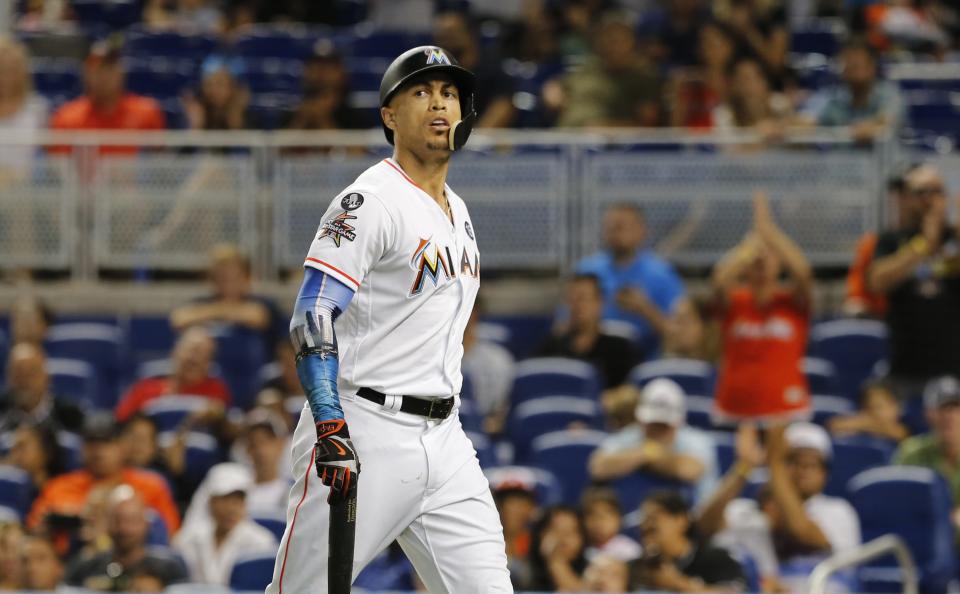Four reasons why MLB's Hot Stove is lukewarm
Over the weekend, executives across baseball hunkered down in their offices to fill out a document. One general manager called it “the most important paper I’ve written since college.” Another scrambled to find someone to translate his version into proper Japanese. An executive, short on sleep, long on frustration, said: “This is so stupid.”
In anticipation of Shohei Ohtani’s posting, the agents for the 23-year-old Japanese star sent a memo to all 30 teams, asking them to explain why Ohtani fits in their organization. Some executives rolled their eyes. Others saw it as an opportunity to differentiate themselves. Each wound up doing the same thing: Putting together their best sales pitch for what everyone agrees is a once-in-a-lifetime player, not simply because of his talent as a pitcher and hitter but the absurd discount in which teams may realize well over $100 million in surplus value.
“Shohei Ohtani,” one agent said, “is like the baseball version of the new Amazon headquarters.”
He is, according to people around the game, a lot of things. A staggering talent, capable of throwing a ball 102 mph from the right side and hitting it like a leviathan from the left side and running with the speed of Mike Trout despite standing 6-foot-5 and 230 pounds. A complete mystery, part of which is adding to executives’ agita, in that because they know so little about him, they aren’t certain how, exactly, to frame their answers to the questionnaire. A bargain, seeing as the largest signing bonus he’ll receive is $3.5 million and the fee owed his Japanese team, the Hokkaido Nippon Ham Fighters, is only $20 million.
“This is a $200 million Powerball in a 30-person town,” one National League executive said. “You kind of have to buy a ticket.”

Here’s what Shohei Ohtani isn’t: The reason the 2017-18 free-agent market is suffering from some unholy rush-hour-caliber gridlock. For the prevailing wisdom that the uncertain status of Ohtani and trade limbo of Miami Marlins slugger Giancarlo Stanton has brought baseball to the end of November with Doug Fister the only free agent signed and no trades of significance executed, the reality, nearly 20 executives, agents and officials from the league and union told Yahoo Sports, is that neither is impeding much at all.
“I don’t buy the Ohtani thing, because no matter what you do, he fits. He’s cheap. He’s great. If you get him, it’s a bonus,” one GM said. “You’ve had a lot of time to get [things] together. I don’t buy that you’re spending a [ton] of time on it. And I don’t really buy the Stanton thing. J.D. Martinez is the only guy on the market you can squint and see some effect there.”
As another agent put it: “If Ohtani weren’t coming and the Marlins were keeping Stanton, they’d come up with two other things to slow the market down.”
This is the crux of the stalemate: While a number of factors have caused it, they are no mistake and have conspired to turn the Hot Stove lukewarm, according to officials on both sides, who spoke with Yahoo Sports on the condition of anonymity because the league and union frown upon public discussion of free agency. Among the reasons:
1) Four-corners free agency
With apologies for the mixed-sport analogy, teams believe bleeding out the clock on free agents is an effective way to drive down prices – and players haven’t figured out a proper way to combat it. In the past, executives said, this affected third- and fourth-tier free agents.
And while some believe the pace of signings will turn this week – a sage of past markets said he sees seven to 10 players, many among them relief pitchers, signing in the next week – the chill has been noticeable and troublesome.
“The clubs each believe, and maybe correctly, that the longer they wait, the prices will come down,” one longtime official said. “That usually has not been the case as it relates to the premier free agents, so either there’s nobody in this marketplace that teams wouldn’t live without or it’s just the latest turn that even for premier free agents we’re going to delay, delay, delay.”
One GM confirmed as much. “Of course I’m waiting,” he said. “Because they’re going to worry they won’t get a job and I’m going to get a discount.”
Teams hope to prey in particular on those without experienced agents or those with a small client list, hoping fear of player and agent leads to a decision ripe with moral hazard. One veteran agent already is planning on telling his clients: “Remain confident. They have to fill the roster. At some point, they have to spend the money they earmarked. There’s no sense for you to panic.”
2) Manfred University
An underappreciated element of the utter sameness that permeates baseball today is the number of executives who came through the commissioner’s office at Major League Baseball either as an intern or early in their careers. Jobs there aren’t just pipelines to teams. They are breeding grounds for the proliferation of commissioner Rob Manfred’s doctrine, honed during two decades as the sport’s chief labor negotiator.
How does it work? Consider the case of Tommy Hunter, the relief pitcher, who late last winter was holding out for a major league contract. On the same day, according to two sources, at least two teams called Hunter offering the exact same deal – an occurrence that in the past might have screamed of collusion. In this case, the sources said, it was likelier a reflection of how teams value players so similarly.
It’s not just the algorithms with minuscule differences that spit out the same numbers. It’s a recognition of how to manipulate the new collective-bargaining agreement. “Clubs are maneuvering to take advantage of the significant salary depressors in the CBA,” one agent said. An example: One large-revenue team telling agents that his team is wary of getting anywhere close to the luxury-tax threshold, lest it be penalized for exceeding it.
“Of course that’s what we’re saying,” the GM said. “We’d be stupid not to.”
3) The job shuffle
Since the end of the season, a full third of teams have changed pitching coaches. Six have sought new managers. And that doesn’t begin to address the behind-the-scenes organizational churn that four general managers said has taken up a significant amount of time that normally would’ve been devoted to trades and free agents.
“I feel like an HR director,” one GM said. “It has been so much crazier this offseason than I’ve ever seen.”
While agents don’t buy this line of thinking – “Talking point,” one snarked – the GMs insisted that the bandwidth drain was real. Some organizations have lost as many as a dozen front-office and on-field employees this offseason, leaving days filled with interviews instead of roster planning.
4) The dull of free agency
The standard thought is this is entirely management-driven, and there’s certainly an element of truth to that.

“You can’t be a genius if you spend on free agents,” an official said. “That’s the world we’ve evolved into. You can’t be a genius unless you’re winning a few more games on a low payroll. And they’re all looking to be geniuses.”
Added a GM: “Teams are smarter. They know how terrible free agency is.”
Those are fighting words: “They know how terrible free agency is.” The union was built on free agency. Even a decade ago, free agency was seen by players as a panacea. Well over a billion dollars will be spent on free agents this winter.
There remains concern inside the union that something has changed. The number of players looking for under-market, pre-arbitration deals – the sort that almost always end up with a player hitting free agency in his 30s, by which point teams can argue he’s past his prime – has grown. Generational money is available to them, and even some future stars prefer to hedge against both their own fallibility and the sport’s unpredictability.
“There was a time when players always wanted to be the next guy to be the highest-paid,” one official said. “This group of players has lost that. Enough is enough is the attitude.”
And yet that same official cautions that the market this year may not predict those in the future. Remember, while the Class of 2017-18 may lack superstars beyond Ohtani – the best of the rest include Martinez, Yu Darvish and Eric Hosmer – next offseason’s group includes Bryce Harper, Manny Machado and Clayton Kershaw, among many, many more.
It will serve as the best litmus test of free agency yet, as a pillar of the sport offers an all-timer class in a moment when the teams harp on the inefficiency of money spent during the winter. If it churns to a stop as this winter has thus far, it may portend something far worse than a market that’s stuck. That is the seed of labor strife, planted in winter, blossoming in spring and imperiling the quarter century of peace that has allowed baseball to grow into this $10 billion-a-year game where everyone wants their piece of the pie.
More from Yahoo Sports:
• Curry defended by wife after apparent fan snub
• Trump again hammers NFL: ‘American public is fed up’
• Abdul-Jabbar: LiAngelo Ball stained my legacy
• NFL comes down hard on two of its star players


